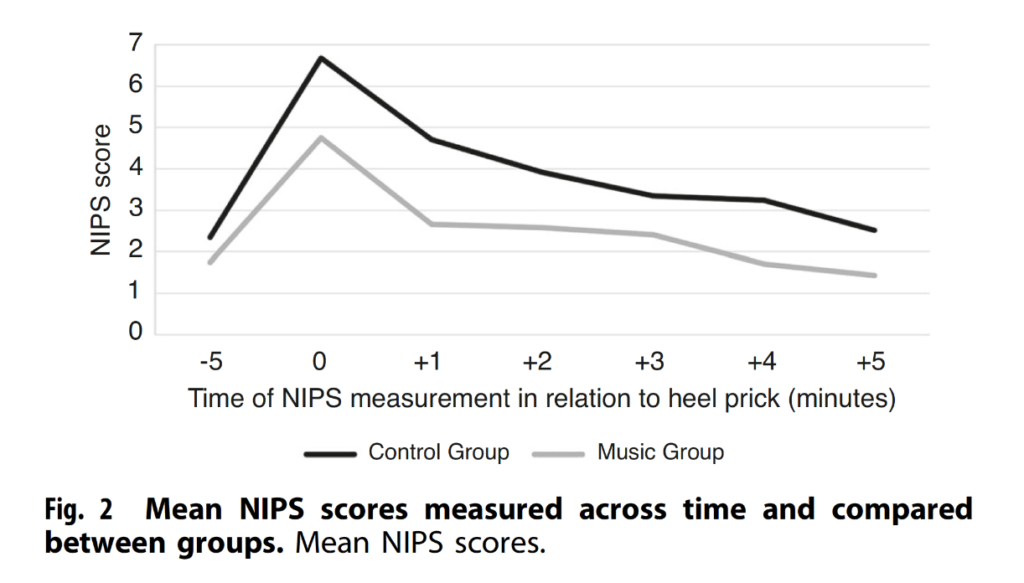
Music as pain relief in newborn procedures
Recently, a research article has been published on using music for pain relief in newborns performed during minor procedures, such as a lancet puncture, to obtain a blood sample.
The research
This randomized, controlled, and blinded clinical trial was conducted at the Lincoln Medical & Mental Health Center neonatal unit in the Bronx, New York. It included full-term infants who underwent minor procedures that may be painful, such as heel prick tests, to obtain blood samples for metabolic screening or bilirubin analysis.
Newborns with results outside the hearing range, with major congenital malformations, neurological pathologies, or undergoing oxygen therapy were excluded from the study.
Two groups were randomized, one intervention group and the other as a control group.
The intervention
All newborns in the study received the center’s standard intervention: 0.5 ml of 24% sucrose 2 minutes before the heel prick test.
In addition to the above, the newborns in the intervention group were exposed to a piece of music from 20 minutes before the heel prick until 5 minutes after the heel prick was performed. Mozart’s “Deep Sleep” was chosen for its minor and soft tones. The music was listened to by the neonate through headphones connected to a cell phone that was placed near the baby’s ear.
Once the heel prick was performed, an external researcher, who did not know whether the subject was in the intervention or control group, assessed the pain using the Neonatal Infant Pain Scale (NIPS).
In the control group, the mobile phone did not emit music, and the headphones were in a similar position, so the external researcher could not identify whether they were in the control or in the intervention group.
During the research, the newborns were not in the arms of their mother or relatives so as not to confound the results of the study because current scientific evidence shows that skin-to-skin, holding by the mother or relatives and breastfeeding at the time of the puncture significantly and drastically reduce the score on the pain scales (NIPS).
The research was conducted on a total of 100 newborns, 46 in the control group and 54 in the intervention group, between April 2019 and February 2020.
Results
The intervention group had significantly lower scores on pain measurements using NIPS, regardless of infant sex or time.

Table extracted from the publication by Anbalagan, S., et al (2023) comparing the control group with the intervention group.
Limitations
The authors point out several limitations of this research described in the publication, including the inability to perform the interventions recommended by the current scientific evidence of not separating newborns from their families and the use of skin-to-skin care. Also, the recommendation was that family members should not feed their babies for at least one hour before the intervention was given. Fortunately, this was not followed by many families.
Considerations
It should be noted that research such as this can have negative consequences. We have quality scientific evidence that recommends not separating the mother and newborn at any time.
Non-separation of the mother-newborn pair not only brings benefits in terms of health and pain relief in certain painful procedures but also increases satisfaction and a sense of self-efficacy on the part of the mother, which is related to a better bonding of the mother with the newborn and improved breastfeeding rates. We do need an increase in knowledge in maternal and newborn care. But without a doubt, this must be scientific research with a critical eye, which enhances physiology and includes a gender vision.
We would like to point out that, of course, when there is no possibility for the mother and newborn to stay together, it may be time to use effective substitute pain relief methods. However, the study concludes that it can be a good system for pain management in healthy newborns, which is not accurate.
References
Anbalagan, S., Velasquez, J. H., Staufert Gutierrez, D., Devagiri, S., Nieto, D., & Ankola, P. (2023). Music for pain relief of minor procedures in term neonates. Pediatric research, 10.1038/s41390-023-02746-4. Advance online publication. https://doi.org/10.1038/s41390-023-02746-4
Johnston, C., Campbell-Yeo, M., Disher, T., Benoit, B., Fernandes, A., Streiner, D., Inglis, D., & Zee, R. (2017). Skin-to-skin care for procedural pain in neonates. The Cochrane database of systematic reviews, 2(2), CD008435. https://doi.org/10.1002/14651858.CD008435.pub3
Harrison, D., Reszel, J., Bueno, M., Sampson, M., Shah, V. S., Taddio, A., Larocque, C., & Turner, L. (2016). Breastfeeding for procedural pain in infants beyond the neonatal period. The Cochrane database of systematic reviews, 10(10), CD011248. https://doi.org/10.1002/14651858.CD011248.pub2
Cong X. (2017). Skin-to-skin care is an effective and safe intervention to reduce procedural pain in neonates. Evidence-based nursing, 20(4), 113. https://doi.org/10.1136/eb-2017-102684
Sharma, H., & Ruikar, M. (2022). Kangaroo mother care (KMC) for procedural pain in infants: A meta-analysis from the current evidence of randomized control trials and cross-over trials. Journal of family medicine and primary care, 11(4), 1250–1256. https://doi.org/10.4103/jfmpc.jfmpc_1383_21